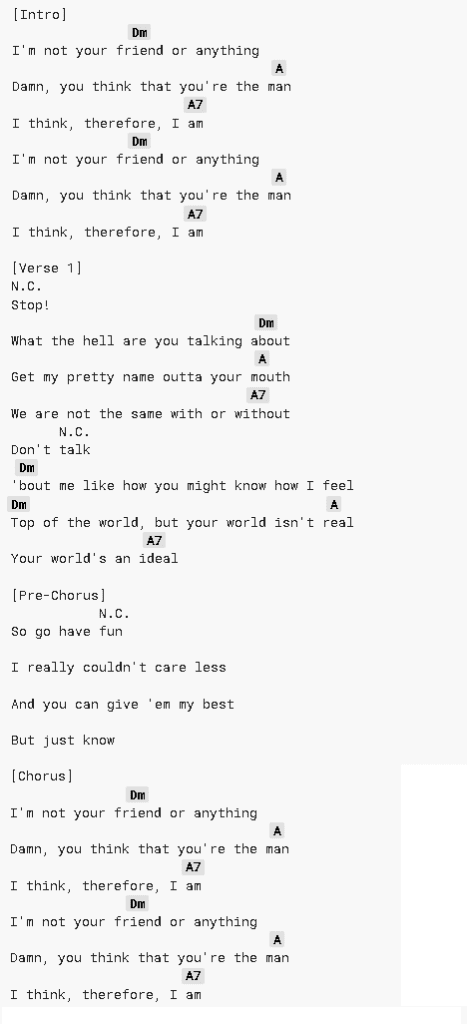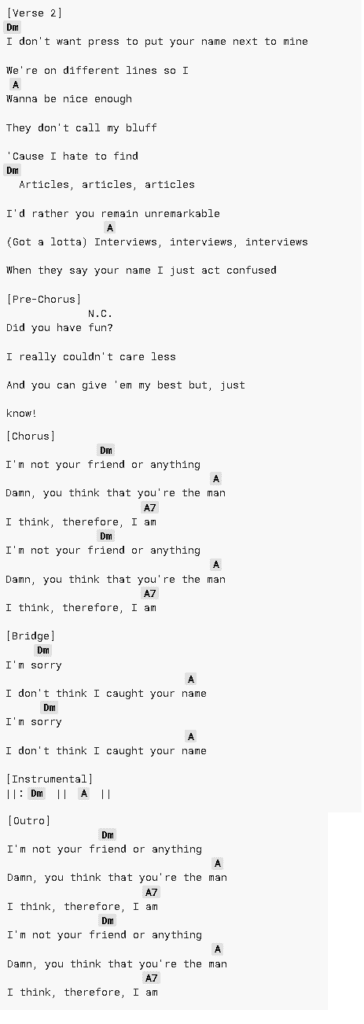

In this Guitar Control lesson video instructor Sean Daniel, will show you how to play “Therefore I Am” By Billie Eilish from Billy and Phineas songs. They are pretty easy to play, and you can do a lot of things actually with them.
Check the image above to follow the chords and tabs, so let’s start playing.
Step 1: Three Chords like Two Chords in One Variation
It’s great how simple these three chords are, like two chords in one variation. Getting started we start with the d minor chord, and were going to do a couple of different ways on how to play it. First, we start off playing the pretty traditional d minor chord voicing where your pointer finger is the first fret on the highest string. I actually like using my pinky for the third fret on the b string, and then middle finger second fret for the g string, and then open d, where this is our root note.
Next were going to go through the chords, and use a strong pattern, which I really think is very important. In this song, we must know the feeling of what the bass guitar or the bass synth is doing.
Step 2: Going to Major Chord and Strumming
Were going to go to a major chord, which again is open on the a string, where there is a root note middle finger ring finger pinky, 2, 2, and 2, d, g, and b. A lot of different ways you can play with this a major chord, I would suggest using this particular chord voicing because of what we’re going to do next part, again you must open e string to have a seven. Open a 2d open g to b so, going from this a major to this a7, lift your ring finger or move your ring finger down to get it right, so we do have d minor two bars worth one bar of a major and then a bar of a seven, but that does not really cover all the strumming. Do not forget to add the strumming. I believe, is one of the important parts of it and should be sounding like this.
Step 3: Outlining the Song and Singing the Lyrics
You can totally play it or want to outline the song and potentially sing along with it. There is really nothing wrong with just hitting the chord and singing the lyrics. Yes, that is great practicing, but I think to get some of the original vibes we must know, what the bass line is doing, we want to do this, what I am doing is. I am not changing the chord with my fretting hand, I am working through the string set with my pick or fingers.
If you want, you can use your fingers through the same thing as what I am doing. We got the bottom highest four strings, so what I am going do is to have one, two, three, four beats in this bar. I am going to break the band of the bottom four strings into three spots. We have the d and the g string, the g and the b string, and the b and the high e strings. For that first beat, I am going to aim for the d and the g string. For the second beat, I am going to aim one string higher g and b together. For that third beat, I am going get b and e. Again you don’t have to get it precisely every time you aim for that and then going back to that middle band of two strings.
It ends up sounding, like echoes sounding a lot of what the original is doing because we are making an acoustic guitar representation of that song. Doing the same thing with all the chords shows how the bass line really follows the outline of the chords you can do, the typical one, and totally plays that song again. I think improving it a little bit more so you can honor the original by trying to add what the original composition of instruments is doing. If you look at that bass line, it is kind of like going through the chord. In that way, you will see the same thing as that of a major chord.
Now I’m going to take what I just did before, and just lowering it by a string. I am going for the a and the d string for my one. The first beat and every b is going to get two strums, could go down off like going down, down, down, down, down, down, down for this. It drives it forward a little more. Going a and d together, then d and g g and b or maybe for that third one. I am getting the highest three strings and then coming back to the middle, instead of going one and two and three and four. You can even hear that I am not always hitting just the strings, not just like two strings at a time, every single time, sometimes I might hit an extra string, sometimes I only hit one of the strings because I have got the pattern of playing in time with each other. It always sounds intentional, but it is not as hard. You do not have to be as hard on yourself. I have to hit those two strings every time because they can be kind of difficult. It is never too early to start focusing on and tightening up the scope of the strings. Hitting with the a7 using your pick or fingers.
Altogether, we have the d minor two and three, and four, and to a major, to a7. One thing I like to do is using different chord voicing to add a different place. The next time the verse comes around, it is actually the acapella. We are going the whole thing through with the same chords but using different voicing.
For those chords that are a surefire, a simple way to keep the song interesting is by adding a variety of chords that you use d minor a, a7. One thing I like to do is to play a, d, in this particular d minor chord to give it a different flavor, a little bit of variance. The 10th fret on the lowest string is a, d, a minor chord voicing that you could use. It will be a 10 skip in the a string 10, 10, 10, which is a d minor, and the next best thing is a d minor 11 where your pointer finger is actually on the eighth fret of the b string, this chord is not that difficult but it definitely gives you a different sound.
A clear d minor chord has a way to switch it upright, especially with a lot of these modern songs, I think the magic is seen in a lot of modern songs, it’s more on the production necessarily than the musical arrangement, so when it comes down to making an acoustic guitar, the arrangement you might sound stale if you stick to the same chords. That’s why its important I think is to get different chord voicing into it. For the d minor, we can play and do something different. I always love playing this kind of open top and a major chord over or any chord in a progression.
Basically, what it looks like on an a major bar chord, b and the e string are actually open. Tilting my hand up to get this space in there, so it is 5 e 7, a 7 d 6 g, and open the top right it will be our new a chord we could use. This is probably one my favorite dominant seven a7. A shorthand, for a dominant seventh of the same chord. I really like this chord voicing where my middle finger five on the low e string pointer finger four a ring, finger five d, pinky six g right, and go from the open version of this a7 to maybe something different, giving a little bit of vibe will work really well together. I think that it is valuable to just learning the different chord voicing.
Recap: How to Play Therefore I Am
I hope you enjoyed learning how to play “Therefore I Am” by Sean Daniel, he is such a great guitarist, on which we can learn some acoustic from. He’s pretty much just setting the tone. The style of acoustic and everything he plays is just awesome. There are a few really unique things he does, that would be great to take on your own, add into your bag of tricks, and even use as inspiration to create your own unique sounds by mixing and blending different techniques that are not normally used together. He is also a great person to learn how to write acoustic. You will notice his acoustics are always awesome, a little showy but very well written and structured. They are actually fair and simple. But the way he plays them and how much feel he puts into them really make him stand out.
In general, you can take any song of any kind. Making it a little more exciting to play, and again. There is no wrong with these sick and open chords. But based on experience, one of the best ways to get better is to start adding something new that you are not used to into easy songs. This song is definitely a great example. Anyway, that is how you play it. Let us know if you have any questions, comments, or suggestions in the comment section below. Were always open to new thoughts, ideas, we love to hear your feedback on our videos. Click on the guitar control YouTube channel to watch my other great videos. Together with my other awesome instructors, so like I said, let us know what you think we’ll talk to you. Thank you



